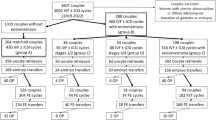Abstract
Purpose
It is controversial who should be recommended to undergo natural cycle IVF (NC-IVF). Therefore, objective prognostic criteria which are already known at the time of counselling were defined.
Methods
A retrospective observational study was performed with 201 couples (age 34.7 ± 4.1) undergoing 311 NC-IVF treatments with 201 transfers, corresponding to a transfer rate of 65.3%. The first cycle resulting in a transfer of one embryo was further analysed. Clinical pregnancy and live birth rates were analysed.
Results
Pregnancy rate and live birth rates per first cycle were 21.9% and 13.2%, respectively. Groupwise comparison revealed the following clinical pregnancy/live birth rates per transfer cycle: duration of infertility 1–2 years 34.3/25.7%, 3–4 years 21.8/14.9% and > 4 years 9.1/4.5%. Women’s age < 34 years 26.3/22.4%, 34–37 years 25.7/18.9% and 38–42 years 15.7/3.9%. Linear regression analysis showed that pregnancy and live birth rate correlated negatively with the duration of infertility and that live birth rate but not pregnancy rate correlated negatively with increasing female age. In contrast, AMH and infertility factors did not correlate with the success rate. Statistically significant correlations remained if a multivariate logistic regression analysis was performed, supporting further that the duration of infertility (OR 0.61, 95% CI 0.42–0.86) (P = 0.006) and female age (OR 0.87, 95% CI 0.78–0.95) (P = 0.008) are the predictors for live birth rates in NC-IVF transfer cycles.
Conclusions
Based on the success rates, NC-IVF can especially be recommended for women with short duration of infertility and young age, whereas older women and those with long duration of infertility are not the best candidates for this technique.


Similar content being viewed by others

References
Gordon JD, DiMattina M, Reh A, Botes A, Celia G, Payson M (2013) Utilization and success rates of unstimulated in vitro fertilization in the United States: an analysis of the Society for Assisted Reproductive Technology database. Fertil Steril 100:392–395
FIVNAT annual reports of Swiss IVF IVF registry “Fécondation In Vitro National” www.fivnat-registry.ch. Accessed 30 Dec 2018
Haemmerli Keller K, Alder G, Faeh M, Rohner S, von Wolff M (2018) Three natural cycle IVF treatment imposes less psychological stress than one conventional IVF treatment cycle. Acta Obstet Gynecol Scand 97:269–276
von Wolff M, Rohner S, Santi A, Stute P, Popovici R, Weiss B (2014) Modified natural cycle in vitro fertilization an alternative in vitro fertilization treatment with lower costs per achieved pregnancy but longer treatment time. J Reprod Med 59:553–559
Aleersma T, Farquhar C, Cantineau AE (2013) Natural cycle in vitro fertilisation (IVF) for subfertile couples. Cochrane Database Syst Rev 8:CD010550
van Loendersloot LL, van Wely M, Limpens J, Bossuyt PM, Repping S, van der Veen F (2010) Predictive factors in in vitro fertilization (IVF): a systematic review and meta-analysis. Hum Reprod Update 16:577–589
Wang YA, Healy D, Black D, Sullivan EA (2008) Age-specific success rate for women undertaking their first assisted reproduction technology treatment using their own oocytes in Australia, 2002–2005. Hum Reprod 23:1633–1638
González-Foruria I, Peñarrubia J, Borràs A, Manau D, Casals G, Peralta S, Creus M, Ferreri J, Vidal E, Carmona F, Balasch J, Fàbregues F (2016) Age, independent from ovarian reserve status, is the main prognostic factor in natural cycle in vitro fertilization. Fertil Steril 106:342–347.e2
Kasius A, Smit JG, Torrance HL, Eijkemans MJ, Mol BW, Opmeer BC, Broekmans FJ (2014) Endometrial thickness and pregnancy rates after IVF: a systematic review and meta-analysis. Hum Reprod Update 20:530–541
Mitter V, Kohl Schwartz A, Fäh M, Griesinger G, von Wolff M (2017) Endometrial thickness is associated with the clinical pregnancy rate in unstimulated menstrual cycles—a study based on natural cycle IVF. Hum Reprod 32(Supp 1):i351–i352
von Wolff M, Nitzschke M, Stute P, Bitterlich N, Rohner S (2014) Low-dosage clomiphene reduces premature ovulation rates and increases transfer rates in natural-cycle IVF. Reprod Biomed Online 29:209–215
von Wolff M, Hua YZ, Santi A, Ocon E, Weiss B (2013) Follicle flushing in monofollicular IVF almost doubles the number of transferable embryos. Acta Obstet Gynecol Scand 92:346–368
Kawachiya S, Matsumoto T, Bodri D, Kato K, Takehara Y, Kato O (2012) Short-term, low-dose, non-steroidal anti-inflammatory drug application diminishes premature ovulation in natural-cycle IVF. Reprod Biomed Online 24:308–313
von Wolff M (2018) The role of natural cycle IVF in assisted reproduction. Best Pract Res Clin Endocrinol Metab. https://doi.org/10.1016/j.beem.2018.10.005
Acknowledgements
We would like to thank Dr. Elizabeth Kraemer for the linguistic revision and correction of the manuscript.
Funding
This study was not funded.
Author information
Authors and Affiliations
Contributions
MvW: design of the study, analysis of data and writing of the manuscript. AKS: preparation of data. NB: statistics. PS: preparation of data. MF: preparation of data. All authors contributed to the manuscript revision, read and approved the submitted version.
Corresponding author
Ethics declarations
Conflict of interest
None of the authors have declared a conflict of interest.
Ethical approval
All procedures performed in studies involving human participants were in accordance with the ethical standards of the institutional and/or national research committee and with the 1964 Helsinki Declaration and its later amendments or comparable ethical standards. Informed consent was obtained from all individual participants included in the study.
Rights and permissions
About this article
Cite this article
von Wolff, M., Schwartz, A.K., Bitterlich, N. et al. Only women’s age and the duration of infertility are the prognostic factors for the success rate of natural cycle IVF. Arch Gynecol Obstet 299, 883–889 (2019). https://doi.org/10.1007/s00404-018-5034-8
Received:
Accepted:
Published:
Issue Date:
DOI: https://doi.org/10.1007/s00404-018-5034-8



